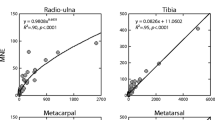Abstract
Zooarchaeologists have long recognized that the number of identified specimens (NISP) is dependent on the degree to which bones are fragmented, but attempts are rarely made to control for the effects of fragmentation on NISP. This paper provides insight into those effects by presenting both a formal model of the relationship between NISP and fragmentation and experimental data on that relationship. The experimental data have practical implications regarding the effectiveness of potential measures of bone fragmentation, suggesting that specimen size—which can be determined easily through digital image analysis—is more useful than other variables that have been or might be used as fragmentation measures.











Similar content being viewed by others
Notes
A proof of this, for the simple case where ε = 1 (in which case the math is relatively tractable), is that the first derivative of the NISP function will equal 0 when F = β/2 + 1/2σ and that it will be positive at lower values of F and negative at higher values of F (i.e., the NISP function will be “upside-down U-shaped” with a maximum where F = β/2 + 1/2σ).
References
Binford, L. R. (1978). Nunamiut ethnoarchaeology. New York: Academic.
Broughton, J. M., Cannon, M. D., & Bartelink, E. J. (2010). Evolutionary ecology, resource depression, and niche construction theory in archaeology: Applications to central California hunter–gatherers and Mimbres–Mogollon agriculturalists. Journal of Archaeological Method and Theory, 4, 371–421.
Broughton, J. M., Cannon, M. D., Bayham, F. E., & Byers, D. A. (2011). Prey body size and ranking in zooarchaeology: Theory, empirical evidence, and applications from the northeastern Great Basin. American Antiquity, 76, 403–428.
Cannon, M. D. (1999). A mathematical model of the effects of screen size on zooarchaeological relative abundance measures. Journal of Archaeological Science, 26, 205–214.
Cannon, M.D. (2001). Large mammal resource depression and agricultural intensification: An empirical test in the Mimbres Valley, New Mexico. Ph.D. dissertation, Department of Anthropology, University of Washington, Seattle.
Cannon, M. D. (2003). A model of central place forager prey choice and an application to faunal remains from the Mimbres Valley, New Mexico. Journal of Anthropological Archaeology, 22, 1–25.
Grayson, D. K. (1984). Quantitative zooarchaeology. New York: Academic.
Grayson, D. K. (1991). Alpine faunas from the White Mountains, California: Adaptive change in the prehistoric Great Basin? Journal of Archaeological Science, 18, 483–506.
Klein, R. G., & Cruz-Uribe, K. (1984). The analysis of animal bones from archaeological sites. Chicago: University of Chicago Press.
Lyman, R. L. (1984). Bone density and differential survivorship of fossil classes. Journal of Anthropological Archaeology, 3, 259–299.
Lyman, R. L. (1985). Bone frequencies: Differential transport, in situ destruction, and the MGUI. Journal of Archaeological Science, 12, 221–236.
Lyman, R. L. (1994). Vertebrate taphonomy. New York: Cambridge University Press.
Lyman, R. L. (2008). Quantitative paleozoology. New York: Cambridge University Press.
Lyman, R. L., & O’Brien, M. J. (1987). Plow-zone zooarchaeology: Fragmentation and identifiability. Journal of Field Archaeology, 14, 493–500.
Marshall, F., & Pilgram, T. (1993). NISP vs. MNI in quantification of body-part representation. American Antiquity, 58, 261–269.
Morlan, R. E. (1994). Bison bone fragmentation and survivorship: A comparative method. Journal of Archaeological Science, 21, 797–807.
Nelson, B. A., & LeBlanc, S. A. (1986). Short-term sedentism in the American southwest: The Mimbres Valley Salado. Albuquerque: University of New Mexico Press.
Outram, A. K. (2004). Applied models and indices vs. high-resolution, observed data: Detailed fracture and fragmentation analyses for the investigation of skeletal part abundance patterns. Journal of Taphonomy, 2, 167–184.
Pavao, B., & Stahl, P. W. (1999). Structural density assays of leporid skeletal elements with implications for taphonomic, actualistic, and archaeological research. Journal of Archaeological Science, 26, 53–66.
Rogers, A. R. (2000). Analysis of bone counts by maximum likelihood. Journal of Archaeological Science, 27, 111–125.
Stiner, M. C., Kuhn, S. L., Surovell, T. A., Godlberg, P., Meignen, L., Weiner, S., et al. (2001). Bone preservation in Hayonim Cave (Israel): A macroscopic and mineralogic study. Journal of Archaeological Science, 28, 643–659.
Ugan, A. (2005). Climate, bone density, and resource depression: What is driving variation in large and small game in Fremont archaeofaunas? Journal of Anthropological Archaeology, 24, 227–251.
Watson, J. P. N. (1972). Fragmentation analysis of animal bone samples from archaeological sites. Archaeometry, 14, 221–228.
White, T. E. (1952). Observations on the butchering technique of some aboriginal peoples: I. American Antiquity, 17, 337–338.
White, T. E. (1953). A method of calculating the dietary percentage of various food animals utilized by aboriginal peoples. American Antiquity, 18, 396–398.
Wolverton, S. (2002). NISP:MNE and %whole in analysis of carcass exploitation. North American Archaeologist, 23, 85–100.
Wolverton, S., Nagaoka, L., Densmore, J., & Fullerton, B. (2008). White-tailed deer harvest pressure and within-bone nutrient exploitation during the mid-to-late Holocene in southeast Texas. Before Farming, 2008, 1–23.
Acknowledgments
I am tremendously grateful to Nicci Barger, who provided tireless assistance with the bone crusher experiment and digital image analysis. I also thank the students in my zooarchaeology course at California State University, Long Beach, who helped with the analysis of the fauna from the Stailey site, and Carl Lipo, who suggested the use of ImageJ. Steve Wolverton and two anonymous reviewers provided very helpful comments on earlier versions of this paper. Finally, I thank Virginia Butler, Chris Darwent, and Michael O’Brien for their invitation to participate in the Fryxell Symposium in honor of Lee Lyman in which a version of this paper was presented, and I thank Lee himself for his innumerable, thought-provoking contributions to the field of zooarchaeology.
Author information
Authors and Affiliations
Corresponding author
Rights and permissions
About this article
Cite this article
Cannon, M.D. NISP, Bone Fragmentation, and the Measurement of Taxonomic Abundance. J Archaeol Method Theory 20, 397–419 (2013). https://doi.org/10.1007/s10816-012-9166-z
Published:
Issue Date:
DOI: https://doi.org/10.1007/s10816-012-9166-z




